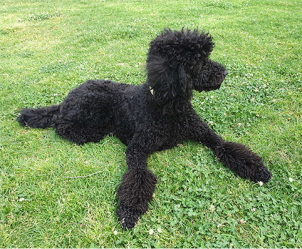I was smelling the flowers in the local park the other day – well, I was really reading the canine news, finding out who’d been where etc, but I think Barbara likes the idea of me being a flower aficionado – and I noticed a young Lab called Marcy getting very worked up trying to figure out what her human wanted. The human was on his phone, trying to stop his coffee from spilling while he ordered Marcy to sit and stay, but Marcy was bouncing around the place, barking and getting progressively more anxious as it became obvious her human wasn’t happy with her.
“Sit, no sit down, no! Sit! Yes! Stay, no! Marcy, wait! Shut up! Sit! Marcy, go back! Look at me, Marcy, Marcy! Here! Heel!” he shouted.
Marcy was not only upset that she was stuffing her tasks up, but she couldn’t keep her eyes off a mini-human who was running around in circles nearby making a high-pitched squealing sound, a bit like a cat you’ve just caught. If I wasn’t so well-educated, I probably would’ve dashed straight over for a squiz myself.
Anxiety in dogs isn’t that unusual. We’re a sensitive lot, desperate to please our humans and often finding ourselves unable to relax and get the commands right. I’ve noticed similar behaviour in humans who spend their days in corporate kennels. They want to do well in the kennel, but when they have information overload, or don’t get clear instructions because no one has time to explain things to them, or are expected to perform business tricks without the resources they need, they get really anxious too. They often don’t call it that, though, they prefer to call it “stress” because it sounds like the sort of thing you get from being really busy or indispensable, whereas “anxiety” is associated with weakness.
I watch them go past our corporate kennel window. They scurry along, earplugs cutting them off from the natural world, wolfing down a sandwich, checking the shopping list in their hand, wondering if there’s really time to do the grocery shopping at lunchtime and trying to figure out how they’ll get that acquittal report done before COB.
Apart from unclear instructions and unrealistic expectations, multi-tasking is also a significant cause of anxiety because it contributes to sensory overload.
Humans talk a lot about mindfulness, but almost everything they do seems to prevent them from actually being in the moment – that feeling of just lying on the feet of your loved one, enjoying the smell of them and thinking about … nothing.
That’d probably do Marcy good too – just being the centre of her human’s attention, with no phone, no mini-humans in tow, no coffee. After all no one likes being peripheral.
She can’t multi-task either. Not yet, she’s only a pup. If she does “sit”, she needs praise and only when she’s really confident about that can she cope with “stay”. And her human needs to make up his mind – is she going to “stay” or “wait”? If she’s going to learn “down”, he shouldn’t say “sit down”. He also needs to decide if he leads with his left or right foot. If he’s consistent, she’ll learn that left foot means heel, and right foot means stay. Consistency doesn’t seem to come easily to a lot of humans.
If Marcy’s getting bombarded with too many, ambiguous instructions she’ll just make even more mistakes and get really anxious. So whether you’re with your loved one in the park, or colleagues in the corporate kennel, give clear instructions; have patience; keep it simple; and be consistent.
Woof!
Louis


